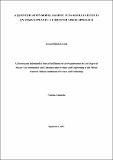| dc.contributor.author | Loyani, Loyani | |
| dc.date.accessioned | 2022-09-12T08:19:20Z | |
| dc.date.available | 2022-09-12T08:19:20Z | |
| dc.date.issued | 2021-09 | |
| dc.identifier.uri | https://doi.org/10.58694/20.500.12479/1602 | |
| dc.description | A Dissertation Submitted in Partial Fulfillment of the Requirements for the Degree of Master’s in Information and Communication Science and Engineering of the Nelson Mandela African Institution of Science and Technology | en_US |
| dc.description.abstract | Tomatoes are among the most commonly cultivated crops in the world. It is considered a high value crop and income resource for smallholder farmers in Africa. Nevertheless, its production
currently endangered by Tuta absoluta pest. The pest has severely damaged tomato yields to
the extent that growers are giving up tomato production due to the high costs and losses
incurred. It causes a heavy loss in tomato produce ranging from 80 to 100% when not
effectively managed. Recently, farmers have been using different methods in efforts to control
the pest. These include using pheromone traps and natural enemies for population monitoring,
planting resistant tomato varieties, and continuous spraying of chemical pesticides, which is
now the main control method. These practices have been proven not to be effective in
controlling the pest; they are time-consuming and relatively expensive. Inspired by the
progression and positive outcomes of computer vision methods in diagnosing a wide variety of
plant diseases and pests, this study proposes a segmentation-based quantification model for
detecting and quantifying Tuta absoluta’s damage to tomato plants. We develop convolutional
neural network models based on U-Net and Mask RCNN architectures for automatic semantic
and instance segmentation respectively using data collected from the field. Experimental
results show that Mask RCNN achieved a mAP of 85.67% and U-Net obtained 78.60% and
82.86% of Jaccard index and Dice Coefficient respectively. Both models were precise in
segmenting the shapes of Tuta absoluta-infected areas in tomato leaves and determine their
extent of the damage. The model was then deployed on the mobile phone to enable farmers and
extension officers in Tanzania to automatically detect affected areas on tomato plants and make
informed decisions on how to control the pest so as to increase tomato production and save
farmers from the losses they face. | en_US |
| dc.language.iso | en | en_US |
| dc.publisher | NM-AIST | en_US |
| dc.subject | Research Subject Categories::TECHNOLOGY | en_US |
| dc.title | A quantification model against tuta absoluta effects on tomato plants: a computer vision approach | en_US |
| dc.type | Thesis | en_US |

